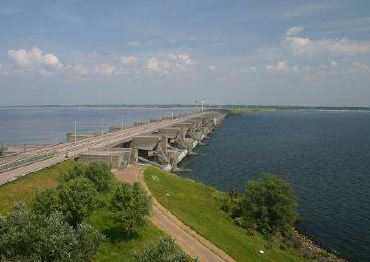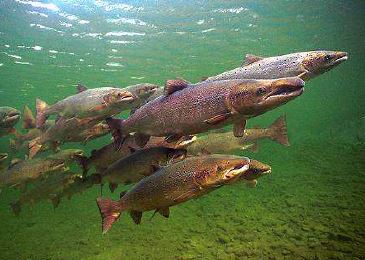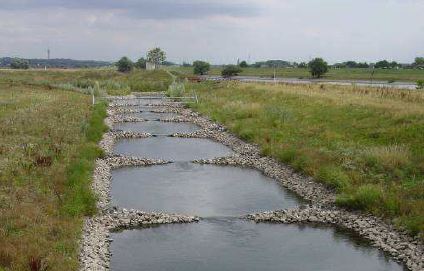EAA position on Salmon and migration barriers - Problems and solutions
 The Atlantic salmon has for ages been the icon for migrating fish as well a symbol of vitality. His name means ‘the jumper’ in Latin, referring to the legendary capacity to jump over water falls that are insurmountable for most other fish species.
The Atlantic salmon has for ages been the icon for migrating fish as well a symbol of vitality. His name means ‘the jumper’ in Latin, referring to the legendary capacity to jump over water falls that are insurmountable for most other fish species.
Since about 40 years the Atlantic salmon populations are declining in all its original habitats. Much earlier – around 1950 – there had been the demise of the once famous populations of the rivers Rhine and Meuse. It proved to be a sad warning of more to come. The downfall of the Atlantic salmon in these great European rivers should have been a forewarning for everybody. However, its causes were so complex and they were not very well understood. Actually, they were never thoroughly studied since nobody seemed to pay attention.
The current decline of Atlantic salmon worldwide is also caused by many factors, and consequently there lurks the serious danger that because of the sheer complexity of all these problems, no actions are taken to correct them. One of the most important factors that negatively influences the survival of the salmon, is the existence of man-made migration barriers.
With this position paper the European Anglers Alliance wants to show you the impact of man-made migration barriers on the survival of the salmon and to contribute possible solutions to address the problem.
Life Cycle
In midwinter the salmon spawns in the gravel beds of rivers and streams. Early in March, about two months after the eggs were laid, the young salmon hatches out and leaves the safety of the gravel and embarks on a hazardous journey out into the open stream. During the course of the next years, the young salmon grows, moving downstream to deeper waters and eventually – after one to three years - makes it way out to the ocean as a “smolt”. There it will stay for at least one year, feeding on smaller fish and growing at a very fast rate. Most salmon however stay two to three years at sea and are called Multi Sea Winter (MSW) salmon.
Salmon that already return in the summer of the year following their journey into the ocean are called “grilse”. So after one to three years in the ocean, the adult salmon begins a return journey which will bring it to the stream in which it was born. It swims gradually upstream where it spawns and thus begins the life cycle of the next generation of salmon.
Migration barriers
Man-made migration barriers like dams and weirs can prevent salmon from reaching their spawning places to reproduce. When this happens the salmon population of a river may diminish to the point that they become endangered or even die out.
Despite it’s reputation as a great leaper, there are man-made barriers that are insurmountable for even the Atlantic salmon. Some migration barriers are less tough, but seem to slow them down during the return migration in such a way that adult salmon do not reach the spawning grounds in time or even turn back to the sea instead of taking part in the spawning process. On the other hand barriers can prevent young salmon (smolts) from reaching the estuary and the sea.
Migration barriers and hydro power stations also make salmon – both young and adults - more vulnerable for predation by fish, birds or mammals.
Man-made migration barriers come in many guises:
- Weirs, dams and sluices for shipping, water management and flood control;
- Weirs and dams for hydropower and irrigation;
- Large bodies of stagnant water created by the impoundments;
- Turbines that are used to generate electric power.
People need weirs, dams and sluices for their safety, for transport and for the production of food as well as energy. But these man-made barriers can turn free flowing rivers into obstacle courses for many migratory fish species. In most cases these structures were built without any regard for the needs of these fish. With the help of fish passages salmon can navigate most of these barriers. Other solutions - depending on the problem - include: fish lifts, guidance systems and a different sluice management.
Hydro power
Hydropower is a problem in its own right (also see the EAA position paper on hydro power). Hydro power stations (and the dams or weirs that come with it) not only constitute serious barriers for upstream and downstream fish migration, but also kill downstream migrating fish, like young salmon, in their turbines right away. Fish are instantly killed or wounded by the impact of the turbine blades or runner (guidance) blades or their spine is broken by hydraulic (shear) forces. Many of the wounded fish die later as a result of these injuries (delayed mortality) or they are not able to complete their migration journey. This problem could by and large be solved by the introduction of fish guidance systems.
Ecosystems and environment affected
An additional problem constituted by hydro power is the profound changes they bring about in natural river systems. Large impoundments or stagnant parts of the river that are the result of hydropower or other projects confuse migrating salmon, get them off their course and make them even more vulnerable for predation. Losses in these stagnant waters by predation can amount to 70% (or even more) of the migrating salmon.
Stagnant waters also change the water temperatures of a river, making the water temperatures significantly higher or lower, depending on the depth of the impoundment.
Negative effects of hydro power:
- High mortality of fish by the turbines;
- Disorientation of migrating fish in impoundments;
- Increased fish mortality by predation in impoundments and below the weirs, dams or turbines;
- Chemical, physical and biological changes in water quality;
- Negative changes in the environment and aquatic fauna of rivers;
- Production of noxious gasses like methane and hydrogen sulphide in the impoundments.
Fish guidance systems
Fish mortality in the turbines of a hydro power station can be prevented or reduced by a fish guidance system. By means of a fish guidance system, downstream migrating fish are diverted past the turbines of a hydro power plant. The reason that until now so very few hydro power stations are equipped with fish guidance systems is that not many tried and tested fish guidance systems are available in Europe. However a much more important argument is the fact that due to the low economic return of some of the plants, virtually no financial room for additional investments is available. In other words: some hydraulic power plants generate too low of a return to install proper fish guidance systems.
Diverting the fish near hydro power plants is not an easy task. Some species (for example young salmon with a length of 15 to 20 cm) migrate to the sea in spring, while other fish species (for example the silver eel with a length of 30 to 100 cm) migrate in autumn. Some species are scared by light, whereas others are attracted by light. It is hard to find a well functioning system that meets all the requirements related to the individual fish species of various sizes. An additional complexity is the requirement that the system should function in extreme changing conditions (high/low dispatch, troubled/clear water and high litter transport).
However, more recently a number of promising fish guidance systems was developed in Europe and the U.S.A.
It should be noted that fish guidance systems are mainly for the downstream migrating fish and other fish passages – like fish ladders – are mainly for the upstream migrating fish.
Fish passages
Most migration barriers can be made surmountable for salmon by the construction of fish passages, sometimes also referred to as ‘fish ladders’. Only with very high dams it is almost impossible – from a cost perspective – to build a fish passage for upstream migrating fish.
Fish passages are essentially bypasses around an obstacle like a weir, sluice or dam. By a water current, upstream migrating fish are attracted to enter the passage. The passage itself consists of a number of basins with water flowing through it that act like the steps of a stairway, enabling fish to negotiate the difference in water levels downstream and upstream of the migration barrier.
There are many types of fish passages but generally the principle stays the same.
At high crest dams, where the financial costs of a standard fish ladder are mostly too high, the construction of fish lifts can sometimes be a solution. A fish lift is essentially a moving water tank. Upstream migrating salmon are attracted by water currents and are enticed to enter the water tank. After enough salmon have entered the tank, it is lifted to the water level above the dam and the fish are released there.
Another new solution at high crest dams may be the construction of a siphon type fish passage, consisting of a large siphon-pipe with a built-in fish ladder.
What the EAA wants
The European Anglers Alliance (EAA) thinks it is very important that migratory fish species like the Atlantic salmon can migrate freely within a river system. Too many rivers in Europe are partitioned by weirs, dams or sluices. Young salmon are unable to reach the sea and returning adult salmon are unable to reach their spawning places. Because of this salmon populations have dwindled or have died out.
The EAA urges the EU and the national European governments to take the following measures:
- Every existing or newly constructed weir, dam or sluice in a river with a salmon population should have an effective fish passage for upstream and downstream fish migration;
- No new hydro power stations should be built in rivers with a salmon population;
- Existing hydro power stations should be provided with effective fish guidance systems for downstream migration of salmon smolts;
- Evaluation studies of the efficiency of all existing fish passages and fish guidance systems at hydro power stations.
- Where and whenever possible, a different sluice management that allows salmon and other migratory fish to enter the upstream waters more easily.
For notes and references please download the position paper
Downloads:


